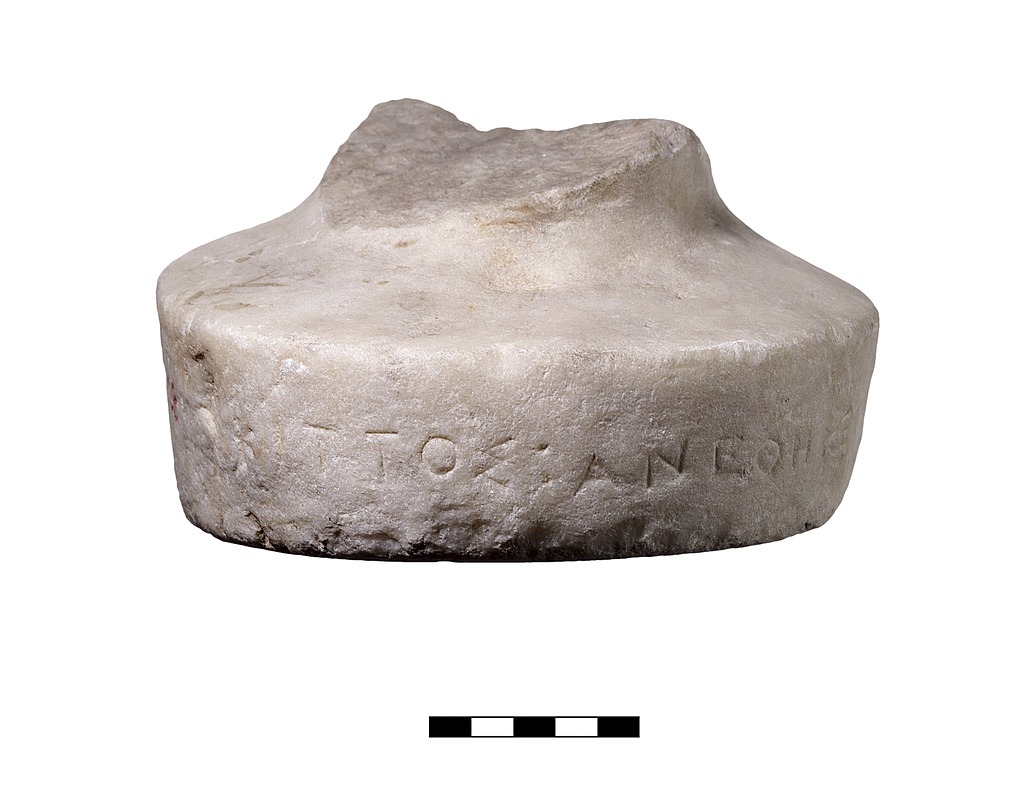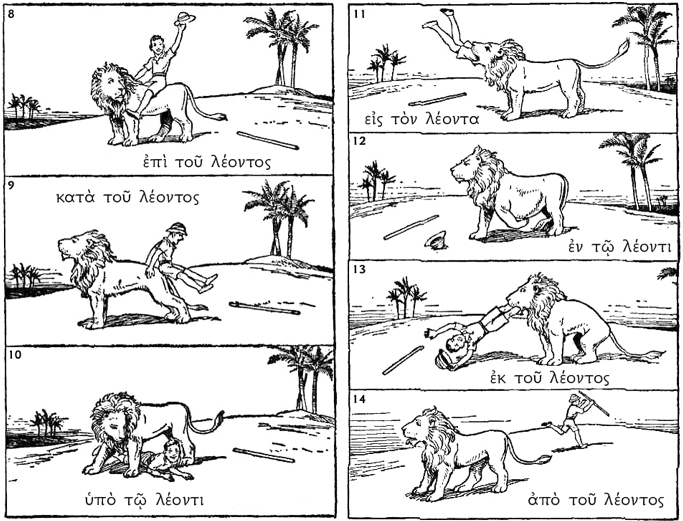
Greek Prepositions
Prepositions in Greek for the most part work as they do in English (S 1636 ff.). The principal difference is that the object of a Greek preposition must be inflected in either the genitive, dative, or accusative case. The preposition together with its object is called a PREPOSITIONAL PHRASE.
The original or core meaning of Greek prepositions often indicates DIRECTION. This chart shows the directions that each case generally indicates:
Three prepositions illustrate this dynamic. Note that these three have no accent.
εἰς + acc. “into”
εἰς τὸ στόμα “into the mouth”
(εἰς is sometimes shortened to ἐς: ἐς τὸ στόμα)
ἐν + dat. “in”
ἐν τῷ στόματι “in the mouth”
ἐκ + gen. “from, out of”
ἐκ τοῦ στόματος “out of the mouth”
(ἐκ becomes ἐξ before a vowel: ἐξ αἵματος)
Accents, Elision, and Aspiration
Prepositions – with the exception of εἰς, ἐν, and ἐκ – normally have an ACUTE accent. If the preposition has two syllables, the acute falls on the ULTIMA.
ELISION is common with prepositions; they frequently drop their final vowel before a word beginning with a vowel. In such cases, the preposition has NO ACCENT. There are two important exceptions: περί and πρό. Neither allows for elision.
After a preposition drops its final vowel, if it then ends in a STOP CONSONANT, that consonant becomes ASPIRATED if the following word begins with an aspirated – i.e., marked with a rough breathing – vowel or diphthong.
ἀπὸ τῆς ἐλπίδος “from the hope”
ἀπ’ ἐλπίδος “from hope”
ἀπὸ τοῦ αἵματος “from the blood”
ἀφ’ αἵματος “from blood”
Prepositions + Accusative Case
ἀμφί around, about
ἀνά up, through
διά because of, through
εἰς/ἐς into
ἐπί against
κατά down, along, according to
μετά after, behind
παρά to, throughout, beside
περί near, around
πρός toward
ὑπέρ above, over, beyond
ὑπό under
Prepositions + Dative Case
ἀμφί around, near
ἀνά upon
ἐν in
ἐπί on, for the purpose of, because of
παρά with, near
περί about
πρός by, in addition to
σύν with (the help of)
ὑπό under
Prepositions + Genitive Case
ἀμφί around, for the sake of
ἀντί opposite, instead of, for the sake of
ἀπό from
διά through
ἐκ from
ἐπί on, at
κατά down, against
μετά with
παρά from
περί about
πρό before, in front of
πρός toward, (swear) by
ὑπέρ over, on behalf of
ὑπό under, by
The Man and the Lion
Note the following story of a man and a lion (ὁ λέων, λέοντος), which illustrates well some of the most common prepositions and their cases.

Prepositions as Prefixes
Prepositions often double as prefixes for verbs. The core meanings of the most common prefixes are as follows.
ἀμφί around
ἀνά up
ἀντί back
ἀπό from
διά through
εἰς into
ἐκ out of
ἐν in
ἐπί on
κατά down
μετά with
παρά beside, to
περί around
πρό before
πρός toward
σύν with
ὑπέρ above
ὑπό under
Prefixes, Elision, and Aspiration
When prefixes are attached to verbs, any final vowel drops out – or ELIDES – if the tense stem to which it is added begins with a vowel. As with prepositions, the prefixes περί and πρό are an exception to this rule, and do not elide. If a prefix drops its final vowel, the remaining consonant becomes ASPIRATED if the tense stem begins with an aspirated vowel or diphthong.
We have already encountered in earlier lessons some verbs that have prefixes. Note the changes that occur to the prefixes in some of these examples.
ἀνίστημι (ἀνα + ἵστημι) raise, appoint
ἀποδίδωμι (ἀπο + δίδωμι) give back
ἀφίημι (ἀπο + ἵημι) let go, allow, forgive
ἐπιτίθημι (ἐπι + τίθημι) put on
καθίστημι (κατα + ἵστημι) set down, establish
παραδίδωμι (παρα + δίδωμι) hand over, deliver
πάρειμι (παρα + εἰμί) be present
παρίστημι (παρα + ἵστημι) present
προστίθημι (προς + τίθημι) add to
ἐν, ἐγ-, ἐμ- in
σύν, συγ-, συμ-, συλ- with
When the prepositions ἐν and σύν are used as prefixes, they retain these forms when the verb begins with a vowel. When the verb begins with a consonant, they ASSIMILATE with this consonant.
- They retain their form (ἐν– and συν–) before a dental (τ, δ, θ)
- They become ἐμ– and συμ– before a labial (π, β, φ, ψ)
- They become ἐγ– and συγ– before a palatal (κ, γ, χ, ξ)
- συν becomes συλ– before λ.
For example:
ἐν + βάλλω = ἐμβάλλω
σύν + λαμβάνω = συλλαμβάνω.
ἐν + ἐργέω = ἐνεργέω
– τὸ τέλος –
Key Terms and Concepts
- PREPOSITIONAL PHRASE
- THE “DIRECTION” OF CASES
- GENERAL RULES FOR ACCENTS OF PREPOSITIONS
- ELISIONS AND PREPOSITIONS
- ASPIRATION OF PREPOSITIONS
- ELISION OF PREFIXES
- ASPIRATION OF PREFIXES
- CONSONANT ASSIMULATION OF ἐν– AND συν–
Vocabulary
Prepositions + Accusative Case
ἀμφί around, about
ἀνά up, through
διά because of, through
εἰς/ἐς into
ἐπί against
κατά down, along, according to
μετά after, behind
παρά to, throughout, against
περί near, around
πρός toward
ὑπέρ above, over, beyond
ὑπό under
Prepositions + Dative Case
ἀμφί around, near
ἀνά upon
ἐν in
ἐπί on, for the purpose of, because of
παρά with, near
περί about
πρός by, in addition to
σύν with (the help of)
ὑπό under
Prepositions + Genitive Case
ἀμφί around, for the sake of
ἀντί opposite, instead of, for the sake of
ἀπό from
διά through
ἐκ from
ἐπί on, at
κατά down, against
μετά with
παρά from
περί about
πρό before, in front of
πρός toward, (swear) by
ὑπέρ over, on behalf of
ὑπό under, by
Exercises
Ι. Some Greek prepositions can only take one case, some two, others three. Rewrite the Greek preposition vocabulary, this time organized by the number of possible cases each can take. Besides each preposition, list its English definition and the case. In other words, your new list should look as follows.
Prepositions that take only one case: ἀντί, instead of, for the sake of (genitive), etc.
Prepositions that take only two cases: διά, because of, through (accusative), through (genitive), etc.
Prepositions that take three cases: ἐπί, against (accusative), on, for the purpose of, because of (dative), on, at (genitive), etc.
ΙΙ. This lesson provides a review of the most common Greek prefixes derived from prepositions. For each, using a dictionary or your own good knowledge of English vocabulary, try to come up one English derivative that uses the same Greek prefix, e.g.: ἀμφί: amphitheater. Note: there is one prefix that does NOT have a common English derivative. Which is it?
III. Practice filling out a blank “Man and the Lion” preposition sheet. A completed one is available here: lion preposition worksheet. A blank one is available here: lion preposition practice.